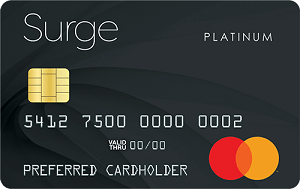Surge® Platinum Mastercard®: Is it worth it?
At its core, the Surge® Platinum Mastercard® is designed to allow consumers to build or rebuild their credit. Unlike secured credit cards, which require applicants to fork over a deposit they can then borrow against, Surge skips collateral in favor of high fees and a prequalification process. Those fees — as much as $275 per year, not including interest — can add up quickly.
On the plus side, the Surge card doesn’t require a security deposit. This could be a saving grace for someone who’s eager to establish credit but doesn’t have the money to set aside as collateral.
You’ll have to watch out for those fees and examine the pros and cons to see if the perks of the Surge card outweigh the drawbacks.
Pros and cons
Surge® Platinum Mastercard® rewards
The Surge Platinum Mastercard isn’t a rewards credit card. You won’t amass points or earn cash back for making purchases. There isn’t a welcome offer or bonus on the table, either.
Fees, rates & limit
The Surge credit card’s biggest claim to fame is its willingness to serve consumers with subpar credit. But to counterbalance the risk assumed by accepting applicants with a poor or nonexistent financial track record, Surge tacks on a number of fees and has a relatively high APR.
Get to know the fine print, including interest rates and possible credit limits, to understand whether Surge is right for you.
Fees
The Surge Platinum credit card comes with an annual fee that ranges from $75 to $125. There are monthly maintenance fees too, totaling up to $150 per year ($12.50 billed monthly). These monthly fees are waived for the first year your account is open.
Other fees include:
- A one-time $9.95 premium card fee
- A one-time $30 additional card fee
- Cash advance fees of 3% of the requested amount or $10, whichever is greater
- A foreign transaction fee of 3%
- Penalty fees of up to $41 for each late or returned payment
Surge doesn’t allow balance transfers and therefore doesn’t charge a balance transfer fee.
Interest rates
Surge Mastercard interest rates are as follows:
-
Regular APR. 35.90% fixed
-
Balance transfer intro APR. N/A
Credit limit
Surge Mastercard credit limits start at $300. That’s the minimum you can expect if your application is approved, but you may be eligible for a limit of up to $1,000, depending on your income, credit score and debt-to-income ratio.
There’s a potential credit limit increase once your account has been open for six months. If you’ve made all your payments on time, you could see your limit double.
How the Surge® Platinum Mastercard® compares
It takes just a minute to skim Surge Mastercard reviews and realize the biggest advantage this bad credit option has over other similar cards is that it’s unsecured. But it also comes with quite a few fees and the APR is on the high side, which could cost you a pretty penny over time.
To better understand which card is best for your needs, let’s look at the Surge Platinum Mastercard versus several other popular options.
Surge® Platinum Mastercard® vs. Capital One Platinum Secured Credit Card
The Capital One Platinum Secured Credit Card automatically has an edge over the Surge Platinum Mastercard because the fee schedule is so much lighter. There’s no annual fee, saving you as much as $125 per year over the Surge card.
Regular purchase, balance transfer and cash advance interest rates all clock in at 30.74% APR, which is over 5% lower than what you’d pay with Surge. But the biggest difference between these two cards is that Surge is unsecured and Capital One Platinum Secured requires an upfront, refundable security deposit. Put down a minimum of $49 to get a $200 starting credit limit, and you’ll be eligible for a boost in six months (no additional security deposit required).
Read our full Capital One Platinum Secured card review
Surge® Platinum Mastercard® vs. OpenSky® Secured Visa® Credit Card
Like the Capital One Platinum Secured card, the OpenSky Secured Visa Credit Card requires a refundable deposit that you essentially borrow against as you build your credit score. A low annual fee of just $35 is far less than you’ll pay with Surge, and OpenSky’s regular 21.89% variable APR is very attractive indeed.
Your potential initial credit limit is intriguing, too — the starting limit can be anywhere from $300 to $3,000, all depending on how much you offer as collateral. You don’t have to submit to a credit check to apply for an OpenSky Secured card, but if you can’t afford the security deposit up front, it’s probably not even worth it to apply.
Read our full OpenSky review
Surge® Platinum Mastercard® vs. Destiny Mastercard®
The Destiny Mastercard® is marketed toward consumers who need help building their credit. But Destiny carries a $175 annual fee for the first year your account is open. That drops to just $49 annually from your second year on, but that’s also when maintenance fees of $12.50 per month kick in. Altogether, you’ll pay $199 just in fees after your first 12 months with Destiny are up.
Adding to the cons list is a regular interest rate of 35.90% variable APR. It’s nice that the Destiny Mastercard is unsecured, so no upfront deposit is necessary. However, the stacked fees make it hard to swallow all the costs when you consider the APR is almost 6% higher than you’d pay with the Surge card.
Read our full Destiny Mastercard review
Is the Surge® Platinum Mastercard® right for me?
The Surge Platinum Mastercard might be right for you if you’re looking for an unsecured credit card that will help you build your credit.
You won’t have to make a deposit up front, but you will pay a high annual fee, monthly maintenance fees in the second year and a 35.90% fixed APR on all purchases.
If you’re eligible for a card with more favorable terms, such as an option with a low annual fee or one that offers points redeemable for travel, that’s probably better for you in the long run. But if you need to build your credit ASAP and don’t have much of a plan B, Surge could be a short-term solution worth considering to help you earn a credit score that opens more doors.
You can also check out these other cards for building credit to see if you find a better fit.
How do I apply for the Surge® Platinum Mastercard®?
You can learn more and apply for the Surge Platinum Mastercard online or on the phone in just minutes, and you should receive a response just as quickly. You don’t even need to worry about your application affecting your credit, as Surge will see if you’re prequalified without pulling your credit report.
To apply, you must be at least 18 years of age and have a valid Social Security number. You may be asked to provide personal details regarding your legal name, address, occupation, annual income and other debts.





































































































































































